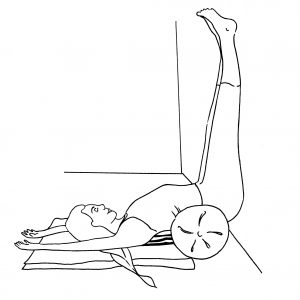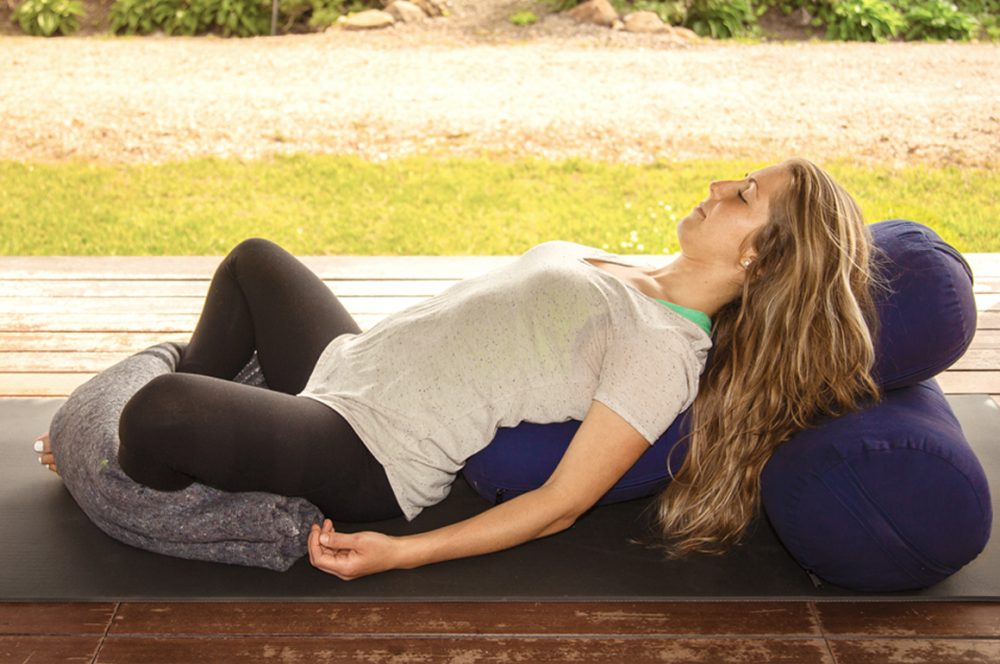Ana Davis looks at why Restorative Yoga is so good for all of us, especially for women
Have you noticed that your yoga practice is becoming yet another task on your daily ‘to do’ list? If the answer is yes then yoga may, paradoxically, be adding to your stress levels!
Women tend to give and give till we have no more to give. As a powerful form of ‘active relaxation’, Restorative Yoga provides us with some much needed time out so that we can refill our energy-tanks and pre-empt exhaustion. Restorative Yoga offers us an opportunity to still practise yoga but to let go of any form of striving that sometimes accompanies the more dynamic styles of yoga, as we instead cultivate the art of just ‘being’.
Restorative yoga is a gentle practice that can teach us to listen to our bodies: to work with our energy, not against it.
Practising restoratively can support women during the low energy ebbs associated with the hormonal fluctuations of our menstrual cycle. It can also benefit any body, male or female, undergoing the negative effects of stress, recovering from illness or surgery, or at any time in our lives when we need to slow down and nurture ourselves.
So what is Restorative Yoga?
Props like bolsters, blankets, chairs and yoga bricks are used to support the body, enabling you to rest and ‘be’ in a yoga posture for relatively long periods of time – anywhere from one to twenty minutes. These longer timings in adapted versions of the classical yoga postures enhances their therapeutic benefits. As you relax, breathe and soften into the support, it feels so blissfully passive that it’s like having yoga done to you!
One of Restorative Yoga’s biggest advocates and craftswomen, Judith Lasater says that by supporting the body with props “we alternately stimulate and relax the body to move toward balance”.
Legs up the Wall
This wonderful restorative posture is a passive inversion that offers many of the benefits of an active inversion and can be practised without strain, when you are feeling tired and run-down.
According to B.K.S Iyengar, Viparita Karani (Legs up the Wall) can relieve stress-related headaches and migraine, as well, asthma, bronchitis and throat ailments.
The most significant benefit of this simple yet profound posture is its incredible rejuvenative power. Well known New Zealand based yoga teacher Donna Farhi describes this pose as “pure ambrosia for the over-worked nervous system”.
Dr Sarah Gottfried, author of “The Hormone Cure”, says that when we place our legs up the wall we activate our parasympathetic nervous system – “the rest-and-digest counterbalance to the flight or flight (or tend and befriend in women) of the sympathetic nervous system”.
In addition, due to the inversion of the body, the diaphragm no longer has to work against gravity, which assists in a fuller exhalation, and in turn, facilitates a deeper inhalation. This causes the heart rate to slow down and also helps decrease blood pressure.
“As the breath deepens the body receives a message that all is well,” says Farhi. “And the positive feedback loop of this good news draws us into a deeper and deeper state of relaxation”.
How to practise Legs up the Wall
Place a bolster an inch or so out from the wall. Sit on top of the bolster, side-on to the wall. Flip the legs up the wall to lie on your back. Shuffle your bottom in as close as possible to the wall – by lifting the hips and walking with the shoulders to bring the bottom in to the wall. In the final posture, the tail-bone drops down a little between the space between the bolster and the wall, and the bolster supports the lower back.
Note: if you are menstruating, practise this posture without any support underneath you, instead rest flat on the floor so that you do not invert the pelvis.
Benefits for Women
This is a great posture for new mothers to rest and renew their energy and for women in early pregnancy to alleviate exhaustion and nausea. It also helps balance the hormonal system so can be beneficial for the various phases of our menstrual cycle and to boost fertility. Plus, it’s a gentle and effective inversion to help balance the hormones for women during menopause.
Ana Davis, Founder and Director of Bliss Baby Yoga, is the lead teacher on our Online L1 & L2 Restorative Yoga Teacher Training courses. Restorative Yoga is also a key aspect which is explored in our Bliss Baby Yoga Prenatal and Postnatal Yoga Teacher Training Course, and features as an important tool for self healing in our Online Level 1 Yoga for Fertility Teacher Training Course. Ana Davis is also available for online on-on-one mentoring if you’d like her expert support and advice with teaching or practising Restorative Yoga.
Ana has a passion for a feminine approach to yoga, and supporting women with yoga through all ages and stages of their life, and is the author of the groundbreaking ‘health bible’ for women, “Moving with the Moon – Yoga, Movement and Meditation for Every Phase of Your Menstrual Cycle and Beyond”.
Illustration by Sophie Duncan www.deerdaisy.com
Further Reading related to this topic:


Comments are closed.